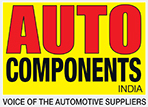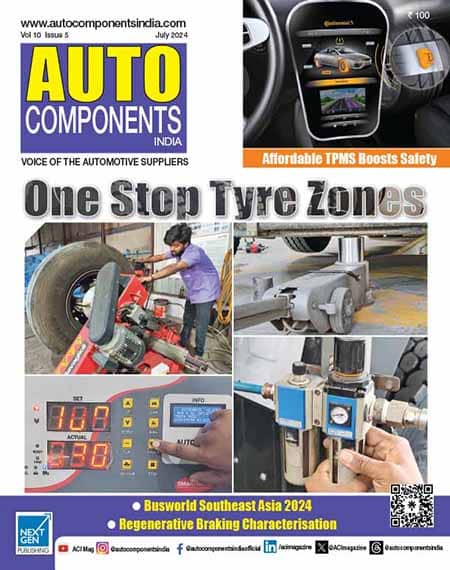Arvind Balaji, the newly elected President of Automotive Component Manufacturers Association of India (ACMA) has taken over the mantle at a time when the industry is witnessing some green shrubs. Loaded with huge responsibilities to take the industry to the growth path, the new President informed Bhargav TS about his top priorities and challenges that need to be addressed. Excerpts from the interview:
Q: What are all your priorities for the auto component industry?
Balaji: The Indian automotive components industry, despite the slowdown in the vehicle industry, has performed reasonably well. In FY 15, the industry scaled a turnover of USD 38.5 billion growing 11% over the previous year while exports touched USD 11.2 billion. Our priorities for future would be to focus on R&D to help generate IP (Intellectual Property) in India, World class quality and process, create the industry’s economic profit i.e. greater returns on capital than the cost of capital to make India an attractive destination for auto components manufacturing investments. In the current year we would like to focus on, creation of new product development and IP creation – graduating from being a ‘build to print’ to one that is ‘art to part’, improving quality capability of Tier-2 and 3 suppliers, facilitating development of emission and safety standards and their adoption in the component sector, growing industry capability, especially people skills to support domestic and global expansion of OEMs, building auto-electronics manufacturing capabilities and embracing digital technology in manufacturing to transform productivity and quality.
Q: According to you, what are all the challenges for industry and in which areas do you need to gear up?
Balaji: The auto component industry is largely dominated by small and medium enterprises. Access to Capital and the cost of Capital is probably the single most significant challenge confronting the industry today. In addition some of the automotive hubs are power deficit which forces the industry to invest in power generation through diesel gen sets, which is significantly more expensive than that of the grid; this makes us non-competitive despite our inherent manufacturing strengths. Lastly, multiplicity and cascading impact of taxes also adversely impacts our price competitiveness. I am hopeful that introduction of GST will help resolve this issue.
Q: Apart from manufacturing, R&D has to be boosted especially in the auto components industry. How are you planning to address this issue.
Balaji: R&D and new product development definitely needs be focused upon to scale the industry to the next level. We need to leverage our strengths in frugal engineering to bring about products that are significantly cheaper and better in quality. The industry also needs to make a conscious effort to move away from ‘Build to Print’ to creation of IP. Further, an another vertical that is completely absent in India is electronics manufacturing which we cannot afford to miss. Therefore, an urgent need to create an ecosystem that allows innovation and R&D to proliferate, ACMA has been recommending to the government. R&D and creation of IP is very fundamental for any industry that aspires to be global and industry-academia collaboration also fuels this move.
Q: The recent ACMA Convention saw speakers talk about quality manufacturing. What will be the efforts taken to improve the quality of manufacturing?
Balaji: Quality is non negotiable in the automotive industry. Today out of over 700 ACMA members, 662 have ISO9000 certification, 554 have TS16949 certification, 19 have QS9000 certification, 295 have ISO14001 certification, 167 have OHSAS18001 certification and 14 have won the coveted Deming Prize.
While the component sector today delivers reasonable levels of quality, we are yet not world-class. It is therefore imperative to raise the bar and this can be accomplished only when the entire ecosystem, especially the tier 2 and tier 3 players start delivering consistent quality at the highest standards. In order to help upgrade the tier 2s and 3s, the tier 1s should need to play a dominant role in hand holding and upgrading them.
Q: What are all the steps to be taken by the industry to achieve AMP 2016-26?
Balaji: The Automotive Mission Plan 2016-26 (AMP 2026) has set the target for the Auto Component Industry to achieve USD 223 billion in turnover from existing USD 38.5 billion, with exports ranging between USD 80 -100 billion from current USD 11.2 billion. To realise this goal the industry needs to focus on internal efficiencies to be able to attract investments of around USD 80 billion, ensure skill development of the existing talent pool, upgrade the capabilities of tier 2s and 3s, and strengthen India’s competitiveness as an investment destination for manufacturing by improving ease of doing business.
As we go forward, I wish to see more collaborative approach between the various elements of the value chain – component manufacturers, OEMs, machine tool suppliers, and the raw material industry. If we have to grow from being locally competitive to globally competitive, our relationship must graduate from being transactional to a mutually beneficial and symbiotic one.
Q: To modernise the auto component industry in terms of product portfolio and technologies, what are all the actions you will take?
Balaji: As India catches up with new technology trends such as light weighting, electrification of power trains, safety and emission norms, the industry will have to evolve to meet the stake-holders expectations. The Indian auto component industry endeavors to be among the top 5 global suppliers in the next few years; where technology will be a key driver in differentiating us from our competitors. The ACMA Centre of Technology is already running a successful cluster program on new product development where several companies are engaged to learn how they could embark on a journey of creating new products and IP. ACMA continues to work closely with some of the leading institutions of the world such as the MIT and the Fraunhofer to help facilitate development of a culture of Innovation in the industry.
Q: Is the component industry ready to cater to the requirements of the electric vehicle sector?
Balaji: Adoption of electric vehicles is still at a nascent stage in India although the government is making some commendable efforts to popularise the same. Unless the EV market in India reaches a critical mass, I doubt if Indian component manufacturers will have a sizeable play in that segment.
Q: How do you see the Indian component industry’s growth panning out in 2015-16?
Balaji: The ‘Make in India’ campaign of the government has enthused the entire manufacturing sector, focus on ease of doing business, implementation of GST and other reforms augur well for the component manufacturing industry. I am optimistic that the industry will perform reasonably well in 2015-16 with growth in double digits at least in some segments.
Q: Auto Expo 2016 is around the corner, what are all the new initiatives we can expect from ACMA?
Balaji: Auto Expo 2016 – Components has shaped up very well, in fact this time in the components show, with over 1100 participants, will be spread across the entire Pragati Maidan in New Delhi from February 04 until 07, 2016. Some of the key highlights include Country Pavilions from Canada, China, Germany, Japan, South Korea, Taiwan, and United Kingdom, dedicated pavilions for bearings and garage equipment, the Asli-Naqli show which is ACMA’s campaign against counterfeiting, live demonstrations of advanced technologies, contest for engineering students called ‘Passion for Innovation’ and focused conferences and seminars.
Q: What’s the latest status on the menace of counterfeit components?
Balaji: Tackling counterfeits is the single biggest challenge facing the after market today; while the after market is estimated to be USD 6.5 billion and growing, almost 36% of components sold in the after market are non-genuine or fake. It is not very easy to identify counterfeits and added to this, purchasing habits influenced by mechanics and purchases without bills/invoice in India, make traceability difficult. Fast-running parts like filters, condensers and spark plugs, brake linings, clutch facings, gaskets, seals and O-rings, ball and taper bearings, PC linkages and fasteners are some of the products most vulnerable to counterfeiting. ACMA, conducts almost 500 raids each year on retailers/dealers on stock counterfeits, however much more needs to be done at the legislative level to make this a cognisable offence, awareness creation at the user’s end to curb this menace.
Q: Can you update on ACMA’s cluster programme?
Balaji: ACMA Centre for Technology (ACT), a technical wing of ACMA, over the last decade has helped upgrade technology within the membership through process interventions. Today, it runs several cluster programs and also runs special cluster programs for the SMEs like ACT MSME Lean Cluster and ACT MSME Advance Cluster. So far more than 500 plants across the country have already benefited from our programs. Further, to help upgrade the capabilities of tier2s and 3s, ACMA has launched the ACMA-UNIDO cluster program with support of the Department of Heavy Industry, Government of India. Over a hundred small and medium auto component manufacturers are taking advantage of this program.
Q: ACMA collaborated with NSDC few years back, what is the update on it?
Balaji: Under the aegis of NSDC, Automotive Skill Development Council – ASDC was set up jointly by ACMA, SIAM and FADA. The ASDC envisions to train 20 million personnel in the next few years. So far the progress is satisfactory, it has worked judiciously towards developing the National Operating Standards (NOS) which are the basic standards for skilling, curriculum for various training programs have been designed and accreditation of institutions to offer training programs is on the way. Till date around 80,000 students across 200 centres, spread throughout the country, have been trained in skills such as machining, servicing, welding and driving. ASDC is now in the process of setting up a mechanism to consolidate the database of the candidates who graduate from various training centres so that companies can easily access this pool of trained people.













